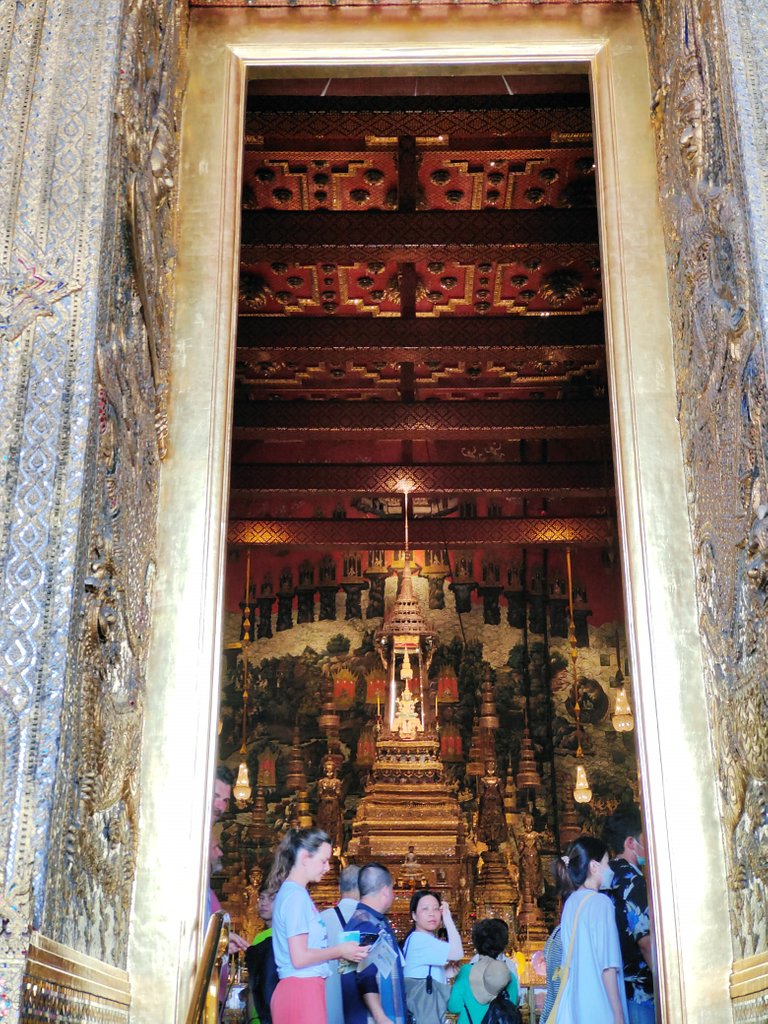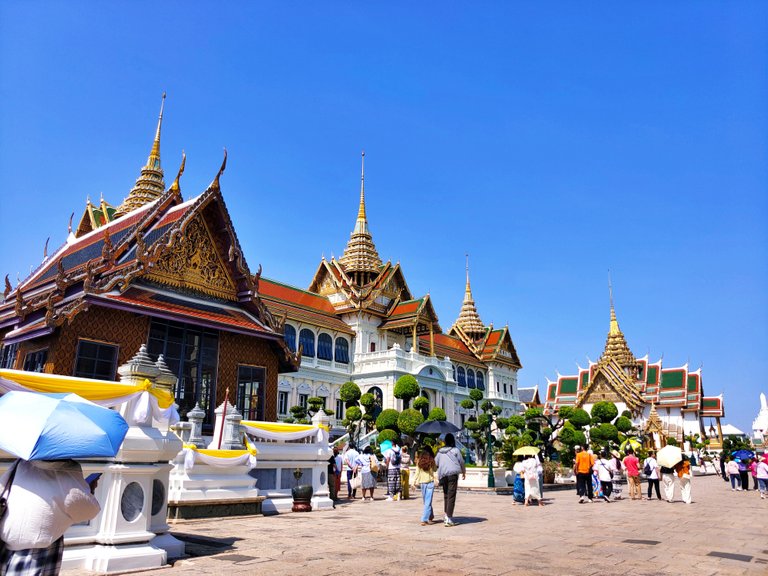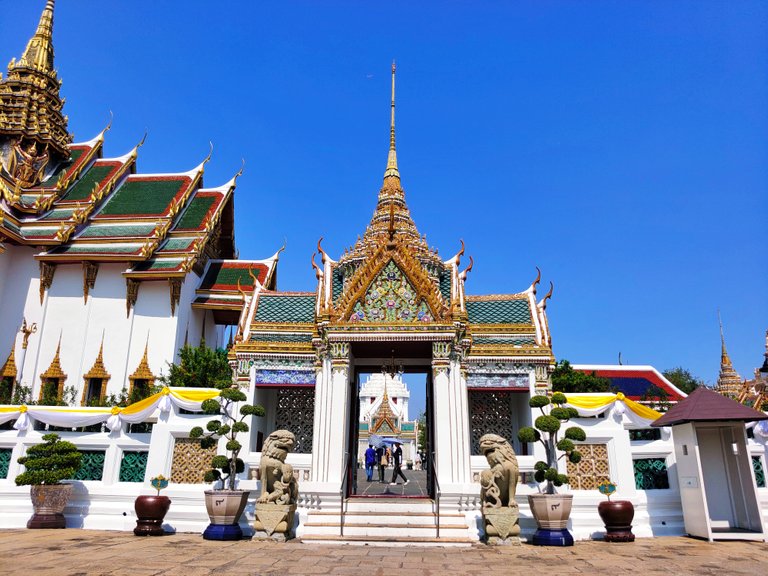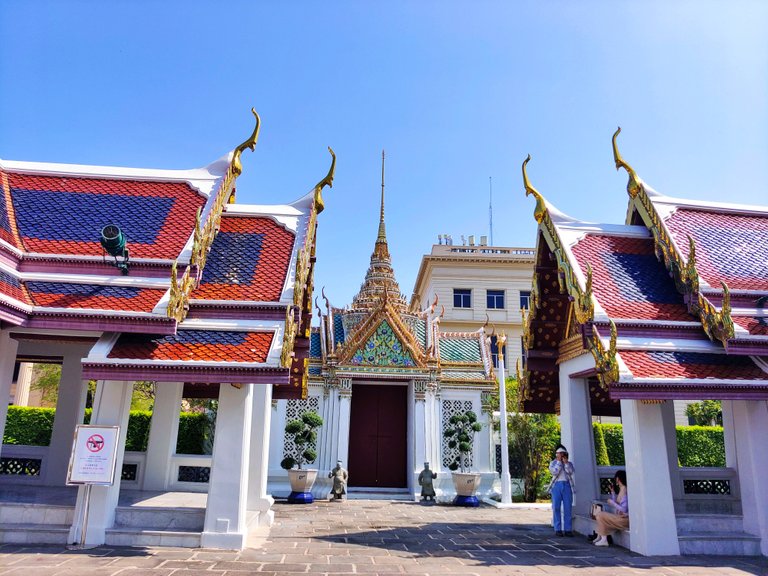Wat Phra Kaew: A Living Museum of Thai Architecture and Spirituality

Hello eveyone
Throughout the centuries, Buddhism and Thai society have shared a profound and enduring bond, shaping the very essence of Thai culture and influencing the lives of its people from ancient times to the present day. This remarkable relationship has bestowed upon Thailand a rich tapestry of spiritual heritage, a legacy cherished by the majority of Thai citizens who hold Buddhism in the highest regard. Their unwavering devotion has led to the construction and preservation of numerous religious sites, each telling a unique tale of faith, resilience, and the indomitable spirit of the Thai people. The origins of this extraordinary affiliation can be traced back thousands of years, when Buddhism first arrived on the shores of the Kingdom of Thailand. As the teachings of the Buddha spread throughout the land, they resonated deeply with the Thai people, offering a profound philosophical framework and moral guidance that resonated harmoniously with their existing beliefs and values. This spiritual harmony served as the catalyst for a deep-rooted and symbiotic connection that would endure through the ages.
In the heart of Thailand's bustling cities, majestic temples stand as timeless witnesses to the indelible impact of Buddhism on Thai society. These architectural marvels, adorned with intricate carvings and golden spires that touch the heavens, serve as sanctuaries of peace and enlightenment. Amidst the ceaseless flow of modern life. Among the most revered Buddhist sites in Thailand is Wat Phra Kaew, located within the grounds of the Grand Palace in Bangkok. Enshrined within its hallowed walls is the revered Emerald Buddha, a precious relic that symbolizes the nation's spiritual sovereignty.

But it is not just the grandeur of these iconic temples that showcases the significance of Buddhism in Thai society. In every corner of the country, from bustling metropolises to rural villages, small Buddhist shrines dot the landscape, serving as reminders of the faith that unites the nation. Thai people, with their deep reverence for Buddhism, actively contribute to the construction and maintenance of these humble abodes of worship, ensuring that their spiritual traditions endure for generations to come.
Beyond the physical manifestations of their devotion, the influence of Buddhism permeates every aspect of Thai life. It shapes their ethical framework, guiding their interactions with one another and instilling values of compassion, kindness, and respect. It is common to witness acts of generosity and selflessness among the Thai people, as they embody the teachings of the Buddha in their daily lives.
Moreover, Buddhism provides a source of solace and support during times of hardship and sorrow. Thai people turn to their faith, seeking comfort and finding solace in the belief in karma and the cyclical nature of existence. The teachings of impermanence and detachment remind us of the transient nature of worldly possessions and encourage us to cultivate inner peace and contentment.

Today, I invite you all to embark on a journey through the rich cultural heritage of Thailand as we explore the magnificent Wat Phra Kaew. Nestled gracefully on Na Phra Lan Road in the Grand Palace Subdistrict, Phra Nakhon District, Bangkok, this revered temple holds within its sacred walls a treasure trove of history, spirituality, and architectural brilliance.
As the sun rises, casting its golden rays over the city, the gates of Wat Phra Kaew open wide, beckoning visitors to immerse themselves in its ethereal beauty. The temple welcomes eager explorers from 8:30 a.m. to 3:30 p.m., allowing ample time to delve into its captivating wonders.
Entrance to Wat Phra Kaew comes with different provisions for Thai citizens and foreigners. Thai people are granted free admission, a heartfelt gesture that symbolizes the unity and reverence shared among the country's inhabitants. For our international guests, an entrance fee of 500 baht is required. This nominal fee not only grants access to Wat Phra Kaew but also includes entry to the illustrious Grand Palace and other temples in the vicinity.
To ensure a seamless and unforgettable experience, it is advisable to secure your tickets in advance through online channels. A visit to the revered Phra Sri Rattana Satsadaram, the Temple of the Emerald Buddha, requires careful planning. Make sure to reserve your ticket at least 24 hours before your desired visit date. The official website of the Royal Grand Palace (https://www.royalgrandpalace.th) serves as your gateway to this extraordinary adventure.


Upon crossing the threshold of Wat Phra Kaew, you are instantly transported into a world where architectural marvels and artistic splendor converge. The temple complex is a true testament to the rich history and cultural heritage of Thailand, showcasing a breathtaking collection of Thai artistry in all its grandeur.
As you step deeper into the temple grounds, your eyes are drawn to a magnificent sight—the giant gatehouse that stands proudly before you. This remarkable structure, crafted with meticulous detail, is a true masterpiece of brick-and-mortar construction. Its towering presence commands attention, a testament to the grandeur and significance of Wat Phra Kaew.

The gatehouse itself is adorned with an exquisite array of colors, thanks to the intricate work of glazed tiles. These tiles, meticulously painted and decorated, breathe life into the architecture, creating a harmonious blend of vibrant hues. Standing at an impressive height of 6 meters, a total of 6 pairs of gatekeepers grace the gatehouse, each one intricately crafted to perfection.
These gatekeepers hold immense cultural and mythological significance, as they are inspired by the characters from the Ramayana, an ancient epic tale deeply rooted in Thai literature and folklore. As you gaze upon their imposing figures, you can almost feel the weight of their mythical prowess and their role as guardians of this sacred sanctuary.
Their presence serves as a reminder of the enduring influence of ancient legends and the importance of storytelling in Thai culture. Through their vibrant depictions, the gatekeepers bring to life the epic narrative of the Ramayana, captivating visitors with their majesty and symbolic representation.


As you make your way around the sacred temple of the Emerald Buddha, you'll discover a remarkable feature that enhances the spiritual atmosphere of the surroundings. A beautiful balcony encircles all the sanctuaries within the temple, offering a vantage point to admire the intricate details and immerse oneself in the rich tapestry of Thai art.
This enchanting balcony serves as a visual feast, adorned with vibrant murals that depict the captivating story of the Ramayana. The Ramayana, a timeless epic of heroic deeds and mythical beings, holds great significance in Thai culture, and the murals serve as a tribute to this cherished tale.
The murals, painted in the traditional Thai style, are a testament to the artistic mastery of the Thai people. They are meticulously crafted using a unique technique involving the use of dust as a medium. The process involves carefully grinding minerals and pigments into a fine powder, which is then mixed with a binding agent and applied to the walls of the balcony. This ancient technique ensures the longevity and resilience of the murals, allowing future generations to appreciate their beauty and storytelling for years to come.

The origin of these exquisite murals can be traced back to the reign of King Buddha Yodfa Chulalok, also known as Rama I, the founder of the Chakri Dynasty and the first monarch of the present-day Kingdom of Thailand. Under his patronage, the stories of the Ramayana were immortalized through these captivating paintings, paying homage to the cultural and artistic heritage of the country.
As you walk along the balcony, the murals come to life, their vibrant colors and intricate details transporting you into the mythical world of gods, demons, and noble warriors. Each brushstroke conveys a sense of emotion and action, capturing the essence of the characters and their timeless struggle between good and evil.

The murals not only serve as a visual spectacle but also act as a narrative guide, guiding visitors through the epic tale of the Ramayana. They depict pivotal moments and significant events, bringing the story to life with vivid clarity. From the birth of Lord Rama to his heroic adventures, the murals offer a glimpse into the rich mythology and spiritual teachings that are deeply ingrained in Thai culture.


Phra Sri Rattana Chedi this remarkable structure, fashioned in the elegant Ceylonese style, stands as a testament to the reverence and devotion bestowed upon the relics of the Lord Buddha. The Phra Sri Rattana Chedi, also known as the Royal Golden Pagoda, is a stupa that serves as a sacred repository for the precious relics of the enlightened one. Steeped in spirituality and adorned with exquisite craftsmanship, this chedi stands as a symbol of devotion and respect, drawing pilgrims and visitors from all corners of the world.





Among the architectural treasures within the hallowed grounds of Wat Phra Kaew, the bell tower stands as a testament to the enduring legacy of Thai craftsmanship. Its history stretches back to the era of Phra Phuttha Yod Fa Chulalok, the revered founder of the Chakri Dynasty, and has undergone transformations throughout the years.
Originally constructed with wood during the reign of Phra Phuttha Yod Fa Chulalok, the bell tower stood as a majestic testament to Thai architectural prowess. However, as time wore on, the structure succumbed to the ravages of age, resulting in its eventual deterioration.
In the reign of King Rama V, a visionary ruler known for his commitment to preserving and promoting Thai culture, the bell tower underwent a magnificent restoration. The rebuilt bell tower, which we have the privilege of admiring today, embodies the Mondop style of Thai architecture.

Within the enchanting grounds of Wat Phra Kaew, you'll discover the remarkable Prasat Phra Thep Bidon. This architectural marvel showcases the distinct Thai-style tetrahedron design, creating a mesmerizing sight that transports you back to the reign of King Mongkut in 1856.
The Prasat Phra Thep Bidon stands proudly with its prang-style castle roof, reflecting the architectural ingenuity and cultural aesthetics of its time. This unique roof design, characterized by its steep and intricate layers, evokes a sense of grandeur and regality. The prang-style roof was a prominent feature of Thai architecture during the reign of King Mongkut, blending traditional elements with innovative design.



As you approach the Prasat Phra Thep Bidon, its tetrahedron structure captures your attention. The tetrahedron, a geometric shape with four triangular faces, forms the foundation of this splendid edifice. It stands as a testament to the meticulous craftsmanship and engineering prowess of the artisans who brought this architectural vision to life. The Prasat Phra Thep Bidon not only boasts an awe-inspiring exterior but also offers a glimpse into the rich history and cultural significance of Thailand.







As you journey through the enchanting realm of Wat Phra Kaew, one of the most captivating sights that should not be missed is the Ubosot. This magnificent structure, resembling a traditional Thai-style building crafted from bricks and mortar, showcases the exquisite artistry of the late Ayutthaya period.
Approaching the Ubosot, your eyes are immediately drawn to its distinct features. The base of the building gracefully curves, resembling the belly of an elephant, paying homage to the revered animal in Thai culture. This unique architectural detail adds a touch of whimsy and symbolism to the structure, capturing the imagination of all who behold it.
The roof of the Ubosot, with its four tiers, boasts the quintessential Thai-style design. Each tier is meticulously crafted, showcasing the mastery of Thai artisans. The intricate details and ornate carvings that adorn the roof further exemplify the rich artistic heritage of Thailand.





Gazing at the pediment of the Ubosot, you'll notice an enchanting engraving depicting the image of Narai, the Hindu deity Vishnu, in the form of a Naga Garuda. This artistic portrayal adds a spiritual and mythological dimension to the architectural masterpiece, evoking a sense of awe and wonder.


Surrounding the Ubosot, the Kankhot Thepanom pattern, intricately lacquered, gilded, and embellished with mirrors, creates a stunning visual spectacle. The interplay of light and reflection adds an ethereal beauty to the surroundings, enhancing the overall grandeur of the temple.



While photography is not allowed inside the Ubosot, this restriction encourages visitors to be fully present in the moment, to connect with the spiritual essence of the temple, and to pay homage to the profound traditions and teachings it represents.

Wat Phra Kaew is home to the renowned Emerald Buddha, a revered icon of Thai Buddhism. This precious statue, meticulously carved from a single piece of jade, is believed to possess great spiritual power and blessings. The Emerald Buddha is adorned with intricate golden robes, which are changed three times a year by the King of Thailand himself, symbolizing the changing seasons.












Allow yourself to wander through the temple complex, indulging in the art of the early Rattanakosin period. Each building you encounter is a testament to the creativity and craftsmanship of generations past. The walls, pillars, and facades of these structures bear witness to the rich history and profound spirituality that permeate every inch of Wat Phra Kaew.
Every step you take within the temple complex reveals a new chapter in Thailand's cultural heritage. The stories come alive through the ornate carvings, vibrant murals, and delicate decorations that adorn the surfaces. Take the time to truly appreciate the intricate details and craftsmanship that have preserved these narratives throughout the ages.

Thank you for your support
ขอบคุณสำหรับการโหวต
เลิฟนะยู้ววววววว


Congratulations, your post has been added to Pinmapple! 🎉🥳🍍
Did you know you have your own profile map?
And every post has their own map too!
Want to have your post on the map too?
Really amazing place to visit. The ancient legacy is present and captivating. I really hope to visit Thailand one day.
Indeed, Wat Phra Kaew is an extraordinary place to visit, filled with a rich ancient legacy that captivates all who step foot within its sacred grounds. Thailand holds a myriad of wonders, and I sincerely hope that one day you have the opportunity to experience its cultural treasures firsthand.
Oh! I can't wait to visit Thailand again! 💛💛💛 Will definitely check this place in Three weeks time 🙂
That's wonderful to hear! I'm sure you'll have an amazing time revisiting Thailand and exploring the wonders of Wat Phra Kaew. Enjoy your trip and create unforgettable memories! 💛💛💛
Hiya, @lizanomadsoul here, just swinging by to let you know that this post made it into our Top 3 in Daily Travel Digest #1901.
Your post has been manually curated by the @pinmapple team. If you like what we're doing, please drop by to check out all the rest of today's great posts and consider supporting other authors like yourself and us so we can keep the project going!
Become part of our travel community:
Thank you so much🙏